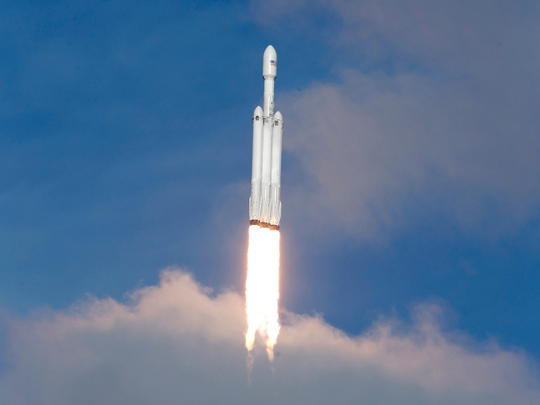
Cape Canaveral, Florida: The world’s most powerful rocket, SpaceX’s Falcon Heavy, blasted off Tuesday on its highly anticipated maiden test flight, carrying CEO Elon Musk’s cherry red Tesla roadster toward an orbit near Mars.
Screams and cheers erupted at Cape Canaveral, Florida as the massive rocket fired its 27 engines and rumbled into the blue sky over the same NASA launchpad that served as a base for the US missions to Moon four decades ago.
“Wow, did you guys see that? That was awesome,” said SpaceX commentator Lauren Lyons as applause thundered through mission control.
Currently over Australia 🇦🇺 pic.twitter.com/HAya3E6OEJ
— Elon Musk (@elonmusk) February 6, 2018
SpaceX commentator John Innsbrucker said it was “everything you could want in a test flight.”
Loaded with Musk’s red Tesla and a mannequin in a spacesuit, the monster rocket’s historic test voyage has captured the world’s imagination.
Falcon Heavy side cores have landed at SpaceX’s Landing Zones 1 and 2. pic.twitter.com/oMBqizqnpI
— SpaceX (@SpaceX) February 6, 2018
SpaceX’s webcast showed Musk’s Tesla roadster soaring into space, as David Bowie’s “Space Oddity” played in the background — with the words “DON’T PANIC” visible on the dashboard, in an apparent nod to the science fiction series the Hitchhiker’s Guide to the Galaxy.
However, the actual status of the car — which was to pass unshielded through a quite harsh environment in space — was not immediately clear.
View from SpaceX Launch Control. Apparently, there is a car in orbit around Earth. pic.twitter.com/QljN2VnL1O
— Elon Musk (@elonmusk) February 6, 2018
If the Roadster does survive, the car would enter an Earth-Mars orbit around the Sun, on a journey that could last a billion years, SpaceX said.
The car was also outfitted with three cameras and a high-data storage unit containing Isaac Asimov’s science fiction books series, the Foundation Trilogy.
About two minutes into the flight, the two side boosters peeled away and made their way back toward Earth for an upright landing.
Both rockets landed side by side in unison on launchpads, live video images showed.
“And the Falcons have landed,” Lyons said.
The third, centre booster was to attempt a landing on an ocean platform. Its status was still unclear a half hour after launch.
Experts said the launch would likely catch the eye of the US space agency NASA, which may consider using the Falcon Heavy as a way to fast-track its plans to reach the Moon again for the first time since 1972.
About 2.5 hours to T-0 for Falcon Heavy. Watch sim for highlight reel of what we hope happens. Car actually takes 6 months to cover 200M+ miles to Mars https://t.co/tC3B26r651
— Elon Musk (@elonmusk) February 6, 2018
Falcon Heavy specs
The Falcon Heavy launched from the same NASA pad that was the base for the Apollo-era Moon missions of the 1960s and 1970s.
It is “the most powerful operational rocket in the world by a factor of two,” SpaceX said.
That means it can carry twice the payload of United Launch Alliance’s Delta IV Heavy, at a far lower cost — about $90 million per launch compared to $350 million for its competitor.
But the Falcon Heavy is not the most powerful rocket ever — just the biggest in operation today.
The Saturn V rocket that propelled astronauts to the Moon could deliver more payload to orbit.
The Soviet-era Energia, which flew twice in 1987 and 1988, was also more powerful.
The Falcon Heavy is essentially three smaller, Falcon 9 rockets strapped together, adding up to a total of 27 engines.
64-tonne payload
Its first stage is composed of three Falcon 9 nine-engine cores
A total of 27 Merlin engines together generate more than 5 million pounds of thrust at liftoff, equal to approximately eighteen 747 aircraft.
The 230-foot (70-metre) tall Falcon Heavy rocket is designed to carry nearly 141,000 pounds (64 metric tonnes) into orbit — more than the mass of a fully loaded 737 jetliner.
Only the Saturn V moon rocket, last flown in 1973, delivered more payload to orbit.
It was initially designed to restore the possibility of sending humans to the Moon or Mars.
But those plans have shifted. Now, the Falcon Heavy is being considered mainly as a potential equipment carrier to these deep space destinations, Musk said Monday.
Instead, another rocket and spaceship combination being developed by SpaceX, nicknamed BFR — known as the "Big Falcon Rocket” — would be the vehicle eventually certified for travellers.
It is aimed to accelerate development of an even bigger rocket to accommodate deep-space crews. Musk's ultimate goal is to establish a city on Mars.
Why is Falcon Heavy special?
SpaceX's Falcon Heavy test flight was one of the most anticipated rocket launches in years.
Among the estimated 100,000 people in attendance around the launch pad was famed Apollo 11 astronaut Buzz Aldrin, who watched as the Falcon Heavy launched from the same pad he used to fly to the moon in 1969.
Part of that allure is the mission's novelty: This Falcon Heavy is the first of its kind, a new breed of reusable monster rocket.
The two side boosters of the first stage have flown before.
One launched the Thaicom 8 communications satellite in May 2016, and the other lofted a Dragon cargo ship for NASA in July 2016, according to SpaceX.
The center core stage was completely new for the Falcon Heavy.












